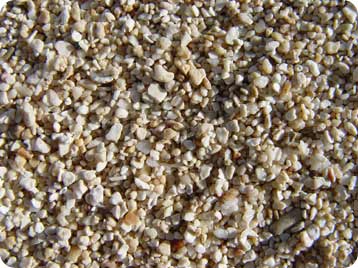On most beaches, the grains of sand that stick to your feet are tiny bits of quartz. But there are some exceptions. The black sand that coats some of Hawaii’s beaches, for example, is made of bits of volcanic rock. And when you walk along some beaches in the Caribbean or other tropical settings, you’re squishing your toes into coral sand -- the remains of countless marine creatures.
 Close-up of coral derived sand. http://en.wikipedia.org/wiki/Coral_sand
Close-up of coral derived sand. http://en.wikipedia.org/wiki/Coral_sandGrains of coral sand consist mainly of calcium carbonate -- the mineral that makes the skeletons and shells of corals, clams, and other marine organisms large and small. When the organisms die, these structures are broken apart and ground to bits by the force of waves and water currents, and by other creatures. In fact, if you look at coral sand under a microscope, you can see some of the colors and textures of the original shells.
Some of the sand comes from living organisms -- especially corals. Algae, worms, sponges, and others can bore into living coral, chipping off some of the coral’s external skeletons. And fish can break off little chunks when they graze on coral animals and algae.
To extract the tender animals from their stony skeletons, for example, a parrotfish uses specially adapted teeth in its throat to grind the chunks of coral to the consistency of sand. The fish swallows the animals with the sand, then excretes the sand into the water with the rest of its wastes.
Over time, storms and waves drive some of the sand ashore -- forming a perfect place to wiggle your toes.

